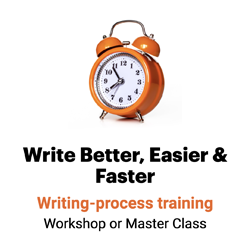Write better, easier & faster with this system
Have you ever come up with a brilliant idea — on the way home from the brainstorming meeting? Developed a creative theme for the annual report while pulling weeds? Written the perfect headline in the shower?

Welcome to the wonderful world of the creative process, where working sometimes doesn’t look like working, and where sticking with it is often the worst thing you can do to move ahead.
I’ve used the five-step creative process every day since I learned it at Hallmark Cards a million years ago. But I’ve recently learned that it was the creation of a pre-Mad Men-era ad executive named James Webb Young, who put it down in a book called A Technique for Producing Ideas.
Forget the idea that genius is 1% inspiration and 99% perspiration. Success for a creative person is at least 51% process. This process can help you develop ideas in minutes that might otherwise take days or weeks or months to develop.
Here are the five stages of the creative process that you can use to come up with a good idea:
1. Forage, or gather information.
This is the “feed your brain,” or preparation stage, of the process. Here’s where you conduct market research and interview sources — or hit the mall, museum and movies — for the raw material that will become your idea or story.
The key thing here is: Get out of your own backyard. The farther afield you seek inspiration, the bigger your ideas will be.
Beware the “but-that’s-not-like-our-project/company/style/industry/specialty” reflex. If you’re only willing to steal ideas from communications that are just like yours — say, the websites of Iowa insurance companies that specialize in agricultural coverage — your ideas will be as limited as your foraging.
Marketing guru Dan Kennedy calls that approach “creative incest.”
“As with actual incest,” he says, “the product of creative incest just keeps getting dumber and dumber and dumber with each generation.”
2.Analyze that information.
Now that you have your raw materials, focus, sift through and organize them to see how the pieces fit together. Look for themes, holes, relationships and structure.
You might call this outlining, writing a walk-away sentence or developing a theme. That’s part of this process, sure. But the real goal is to upload the information to your brain so it can take over while you’re doing something more interesting.
3. Incubate.
During the incubation stage, let the information simmer. This is where you take your eye off the ball and let the back of your mind work on your project for a while. As Agatha Christie used to say, “The best time to write is when you’re doing the dishes.” That’s when the incubation insight shows up.
Don’t have time to do the dishes while a deadline is looming? Instead of taking a break, move on to a new project. Forage and analyze project A, for example, then forage and analyze project B. While you work on project B, you’re marinating project A.
Stuck? Don’t plow through. The best approach may well be to move on.
4. Break through.
This is the aha moment or eureka moment, aka as the insight stage. This is the magical step where your brain presents a brilliant idea fully formed. This is where you come up with answers to questions like “What should I use for my lead?” and “How am I going to organize this thing?”
The French call it “l’esprit de l’escalier” — the wit of the staircase. That’s when you think of a great idea on your way out of the brainstorming meeting or come up with a snappy retort the day after someone makes a snarky remark.
5. Knuckle down.
Take Ernest Hemingway’s advice and “apply the seat of your pants to the seat of the chair.” In other words, turn your great idea into a great story.
Structure creativity.
Many obstacles to good writing actually stem from a bad writing process:
- Suffering from writer’s block? You might not be incubating enough. Trying to force yourself to write before you’re ready is a common cause of blank-page syndrome.
- Dealing with procrastination? You’re probably incubating for too long or at the wrong time — before you forage and analyze, maybe.
- Having trouble coming up with fresh story ideas? You may need to spend more time foraging or forage more widely.
People ask me which is the most important stage. It’s the process, people: Finish the previous stage before you start the next one. You’ll find that you’re able to come up with more ideas — and more that are worth pursuing.
___
Sources: “A 5-Step Technique for Producing Ideas circa 1939,” Brain Pickings, May 4, 2012
James Webb Young, A Technique for Producing Ideas, 1939

Leave a Reply